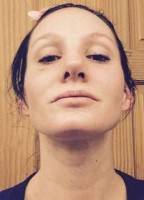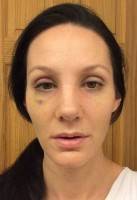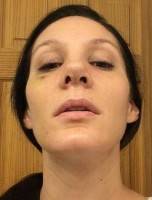Asymmetrical nostrils after rhinoplasty
Correction of Asymmetric Nostrils in Rhinoplasty
Everyone has asymmetry of the nostrils. Correction of significant asymmetry of the nostrils is usually done in one or two ways. The outer part which is called alar flaring has extra skin on the outside of the nose and then there is the inside of the nostril, both be corrected.
They are two different operations. Correction of alar flaring is done with a wedge removal of skin and tissue on the outer aspect of the nose just at the alar base. This must be done very carefully and meticulously to prevent any excessive scarring.
To reduce the size of one nostril to correct asymmetry can also be done, but this must be done in a very carefully planned method so one does not get a notching at the base of the nostril. This requires significant experience and expertise of the rhinoplasty surgeon. (Rod J. Rohrich, MD, Dallas Plastic Surgeon)
Correcting nostril asymmetry
If this asymmetry resulted from septoplasty, the caudal septum is probably curved toward your right side pulling the left soft triangle to a more acute angle while simultaneously flattening the right soft triangle.
If you are happy with the tip from the front (e.g. it is not deviated toward the right), then I would not resort to a columellar strut and septal revision (and possible crural strut grafts), but would adjust the size and shape of the left nostril to more appropriately match the right by a V to Y plasty advancing nasal vestibular mucosa from inside the left nostril above the soft triangle inferiorly.
This is an office procedure that can be performed under local anesthesia. An assistant and fiberoptic headlamp recommended. (Steve Laverson, MD, San Diego Plastic Surgeon)
Correcting assymetric nostrils
Fixing nostrils that are different sizes after nose surgery can be done but is difficult. Everyone has some asymmetry, but some asymmetry is more noticeable than others. While there are many different surgical techniques to correct the different sized holes the risk and benefit ratio should be considered. This should be carefully discussed with your physician as realistic expectations are clearly needed. i often point out asymmetries to my patients prior to having nose surgery as some of these will be more noticeable after surgery. (Carlos Wolf, MD, Miami Facial Plastic Surgeon)
Rhinoplasty to correct asymmetric nostrils
Rhinoplasty is effective at correcting assymetries to some degree, but there are certain genetic asymmetries that can not be corrected. Your surgeon should be able to guide you appropriately as to what to expect from rhinoplasty (Jason B. Diamond, MD, Beverly Hills Facial Plastic Surgeon)
Correcting nostril asymmetry
It is normal in the face and body to have a asymmetry between the left and right sides. It is likely that a skilled plastic surgeon can correct the asymmetry of your nostrils, but one should keep in mind that asymmetry is normal and present in everybody. (Deason Dunagan, MD, Huntsville Plastic Surgeon)
Correction of asymmetric nostrils
In some cases asymmetric nostrils can be corrected, depending on what is causing the problem. In the picture show with this question, the nostrils can be evened with a grafting technique that brings down the rim of the larger nostril. (Howard T. Bellin, MD (retired), Manhattan Plastic Surgeon)
Rhinoplasty can improve the appearance of asymmetric nostrils
Rhinoplasty can improve the appearance of asymmetric nostrils; however, it is almost impossible to guarantee perfect nostril symmetry. Most asymmetries of the nostril are caused by persistent septal deviation and thus can result from a septoplasty, asymmetric tip cartilages either from surgery or preexisting, or deviation of the lower third of the nose. Sometimes nostrils are just asymmetric and if that is the case then there are some techniques that can be performed to shift around, reduce or move the nostrils themselves. (Scott Trimas, MD, Jacksonville Facial Plastic Surgeon)


